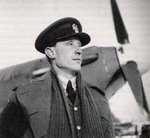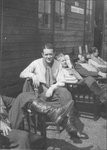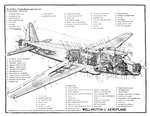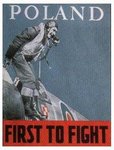diversdream
Airman
(Happy to assist other researching efforts where i can! maybe in exchange for some art but not necessary!)
1 Introduction
Favorite Poems on Lancaster and HMAS Sydney
Where are the bombers, the Lancs on the runways
Snub-nosed and roaring and black-faced and dour,
Full up with aircrew and window and ammo
And dirty great cookies to drop on the Ruhr?
Where are the pilots, the navs. and airgunners
Wops. And bomb-aimers and flight engineers,
Lads who were bank clerks and milkmen and teachers,
Carpenters, lawyers and grocers and peers?
Geordies and Cockneys and Wiltshire moonrakers,
Little dark men from the valleys of Wales,
Manxmen, Devonians, Midlanders, Scouses,
Jocks from the Highlands and Tykes from the Dales?
Where are the Aussies, the sports and the cobbers,
Talking of cricket and sheilas and grog,
Flying their Lancs over Hamburg and Stettin
And back to the Lincolnshire winter-time bog?
Where are the fliers from Canada's prairies,
From cities and forests, determined to win,
Thumbing their noses at Goering's Luftwaffe
And busily dropping their bombs on Berlin?
Where are the Poles with their gaiety and sadness,
All with the most unpronounceable names,
Quietly, ruthlessly flying in vengeance,
Rememebering their homes and their country in flames ?
Where are the Kiwis who left all the sunshine
For bleak windy airfields and fenland and dyke
Playing wild Mess games like high cockalorum
And knocking the hellout of Hitler's Third Reich ?
Where are they now, those young men of all nations
Who flew though they knew not what might lie ahead
And those who returned with their mission accomplished
And next night would beat up the "Saracen's Head"?
The Lancs are no more, they are part of the legend
But memory stays bright in the hearts of the men
Who loved them and flew them through flak and through hellfire
And managed to land them in England again.
(Author Unknown if anyone does know feel free to advise!)
Ode to the HMAS Sydney
By
A R (Lex) Fullarton (former RAN and also ex HMAS Sydney transfered off just before her final criuse)
T'was Banjo who did wrote it,and to to you I will quote it;
No foe shall gather our harvest,nor sit on our stock yard rail:
Now this is a tale of the ocean blue,of an Aussie vessel brave and true;
The HMAS Sydney,and the boys that didn't fail:
T'was race day in Carnarvon and the sun was going down;
When the boys from HMAS Sydney were sailing passed our town:
Another job was over,they'd made another run;
When they chanced upon this bastard,called raider 41
The enemy had travelled far to bring destruction here;
But they'd reckoned not on Sydney,and this would cost them dear:
They swung towards the setting sun,they made for it a chance to run;
They thought that they would sneek away,did Raider 41:
The sharp eyed crew of Sydney saw the Raiders flight;
They closed the gap,they knew they had a fight:
They'd fought before had every mothers son;
They thought that they would capture her,this Raider 41
But the Germans were so clever they had a nasty plan;
She held their destruction did the bowels of Kormoran:
The cloak of her mystery she soon would throw aside;
As she thought to hammer Sydney with shell from side to side:
They set to work with grim profession,they knew their grisely task;
The Sydney,she would sail no more and home had seen them last:
"They've torn our bloody guts out,we'll never make it home;
We'll never see our loved ones or the seas again to roam";
The layer of the turret gave out an anguished cry;
Then we'll take this Bastard with us,cried the boys from turret Y
They snatch another round,they mount to their six inch gun;
They target their tormentor,this Raider 41;
Their ears they are a bleeding,their muscles strain to lay;
Their shot must be a true one in the twilight of the day:
They aim her at his engine room,and there's a mighty crack;
And now these sons of Hitler will never journey back:
Now we'll leave them lying there,their souls have gone to rest;
There passing but a brief one and Carnarvon town was blessed;
Their lying out there somwhere,toward the setting sun;
The HMAS Sydney,her crew,and Raider 41.
1 Introduction
Favorite Poems on Lancaster and HMAS Sydney
Where are the bombers, the Lancs on the runways
Snub-nosed and roaring and black-faced and dour,
Full up with aircrew and window and ammo
And dirty great cookies to drop on the Ruhr?
Where are the pilots, the navs. and airgunners
Wops. And bomb-aimers and flight engineers,
Lads who were bank clerks and milkmen and teachers,
Carpenters, lawyers and grocers and peers?
Geordies and Cockneys and Wiltshire moonrakers,
Little dark men from the valleys of Wales,
Manxmen, Devonians, Midlanders, Scouses,
Jocks from the Highlands and Tykes from the Dales?
Where are the Aussies, the sports and the cobbers,
Talking of cricket and sheilas and grog,
Flying their Lancs over Hamburg and Stettin
And back to the Lincolnshire winter-time bog?
Where are the fliers from Canada's prairies,
From cities and forests, determined to win,
Thumbing their noses at Goering's Luftwaffe
And busily dropping their bombs on Berlin?
Where are the Poles with their gaiety and sadness,
All with the most unpronounceable names,
Quietly, ruthlessly flying in vengeance,
Rememebering their homes and their country in flames ?
Where are the Kiwis who left all the sunshine
For bleak windy airfields and fenland and dyke
Playing wild Mess games like high cockalorum
And knocking the hellout of Hitler's Third Reich ?
Where are they now, those young men of all nations
Who flew though they knew not what might lie ahead
And those who returned with their mission accomplished
And next night would beat up the "Saracen's Head"?
The Lancs are no more, they are part of the legend
But memory stays bright in the hearts of the men
Who loved them and flew them through flak and through hellfire
And managed to land them in England again.
(Author Unknown if anyone does know feel free to advise!)
Ode to the HMAS Sydney
By
A R (Lex) Fullarton (former RAN and also ex HMAS Sydney transfered off just before her final criuse)
T'was Banjo who did wrote it,and to to you I will quote it;
No foe shall gather our harvest,nor sit on our stock yard rail:
Now this is a tale of the ocean blue,of an Aussie vessel brave and true;
The HMAS Sydney,and the boys that didn't fail:
T'was race day in Carnarvon and the sun was going down;
When the boys from HMAS Sydney were sailing passed our town:
Another job was over,they'd made another run;
When they chanced upon this bastard,called raider 41
The enemy had travelled far to bring destruction here;
But they'd reckoned not on Sydney,and this would cost them dear:
They swung towards the setting sun,they made for it a chance to run;
They thought that they would sneek away,did Raider 41:
The sharp eyed crew of Sydney saw the Raiders flight;
They closed the gap,they knew they had a fight:
They'd fought before had every mothers son;
They thought that they would capture her,this Raider 41
But the Germans were so clever they had a nasty plan;
She held their destruction did the bowels of Kormoran:
The cloak of her mystery she soon would throw aside;
As she thought to hammer Sydney with shell from side to side:
They set to work with grim profession,they knew their grisely task;
The Sydney,she would sail no more and home had seen them last:
"They've torn our bloody guts out,we'll never make it home;
We'll never see our loved ones or the seas again to roam";
The layer of the turret gave out an anguished cry;
Then we'll take this Bastard with us,cried the boys from turret Y
They snatch another round,they mount to their six inch gun;
They target their tormentor,this Raider 41;
Their ears they are a bleeding,their muscles strain to lay;
Their shot must be a true one in the twilight of the day:
They aim her at his engine room,and there's a mighty crack;
And now these sons of Hitler will never journey back:
Now we'll leave them lying there,their souls have gone to rest;
There passing but a brief one and Carnarvon town was blessed;
Their lying out there somwhere,toward the setting sun;
The HMAS Sydney,her crew,and Raider 41.




